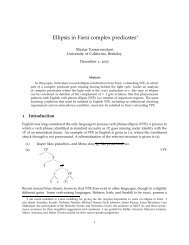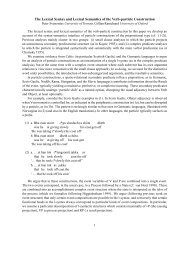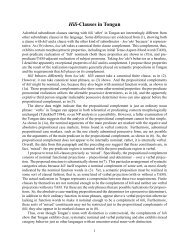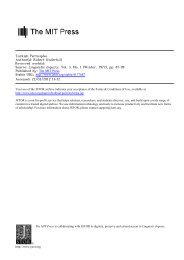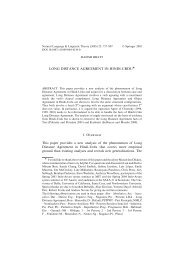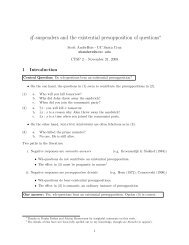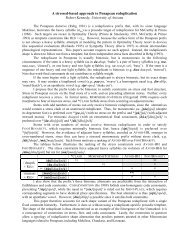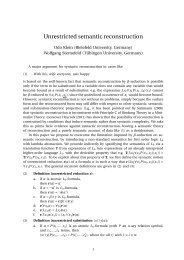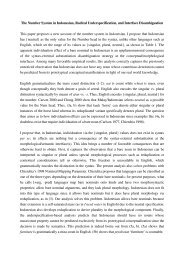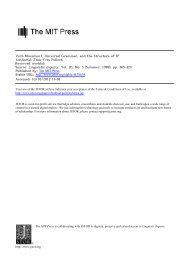1 Weak definites are noun phrases which are definite in form, yet do ...
1 Weak definites are noun phrases which are definite in form, yet do ...
1 Weak definites are noun phrases which are definite in form, yet do ...
Create successful ePaper yourself
Turn your PDF publications into a flip-book with our unique Google optimized e-Paper software.
WEAK DEFINITES AND AMOUNT DEFINITESEdit Doron, The Hebrew University of Jerusalem<strong>Weak</strong> <strong><strong>def<strong>in</strong>ite</strong>s</strong> <strong>are</strong> <strong>noun</strong> <strong>phrases</strong> <strong>which</strong> <strong>are</strong> <strong>def<strong>in</strong>ite</strong> <strong>in</strong> <strong>form</strong>, <strong>yet</strong> <strong>do</strong> not presuppose aunique referent, unlike regular (strong) <strong><strong>def<strong>in</strong>ite</strong>s</strong>. Follow<strong>in</strong>g Poesio 1994 and Baker 2005, weview weak <strong>def<strong>in</strong>ite</strong> <strong>noun</strong> <strong>phrases</strong> as crucially <strong>in</strong>volv<strong>in</strong>g relational <strong>noun</strong>s, and we extend thisapproach to the non-possessive weak <strong><strong>def<strong>in</strong>ite</strong>s</strong> discussed by Carlson and Sussman 2005. Wedraw attention to a type of relational <strong>noun</strong>s <strong>which</strong> has not <strong>yet</strong> been <strong>in</strong>troduced <strong>in</strong> the contextof the discussion of weak <strong><strong>def<strong>in</strong>ite</strong>s</strong> – amount <strong>noun</strong>s, <strong>in</strong>clud<strong>in</strong>g numerals and other measure<strong>noun</strong>s. <strong>Weak</strong> <strong><strong>def<strong>in</strong>ite</strong>s</strong> constructed from amount <strong>noun</strong>s will be called amount <strong><strong>def<strong>in</strong>ite</strong>s</strong>.Amount <strong><strong>def<strong>in</strong>ite</strong>s</strong> have <strong>in</strong> common with amount relatives (Carlson 1977) the <strong>def<strong>in</strong>ite</strong>ness ofthe amount coupled with the <strong>in</strong><strong>def<strong>in</strong>ite</strong>ness of the substance. We propose an analysis of weak<strong><strong>def<strong>in</strong>ite</strong>s</strong>, and explore its consequences by expla<strong>in</strong><strong>in</strong>g the properties of amount <strong><strong>def<strong>in</strong>ite</strong>s</strong>.The term weak <strong><strong>def<strong>in</strong>ite</strong>s</strong> and the orig<strong>in</strong>al examples <strong>are</strong> due to Poesio 1994. Someexamples <strong>are</strong> shown below:(1) John got these data from the student of a l<strong>in</strong>guist.(2) My aunt got attacked by the p<strong>are</strong>nt of a student whom she had failed.(3) He showed me the picture of a veiled woman.Poesio shows that despite the <strong>def<strong>in</strong>ite</strong> <strong>form</strong> of the possessive constructions <strong>in</strong> such examples,they <strong>do</strong> not presuppose uniqueness (leav<strong>in</strong>g aside the strong read<strong>in</strong>g, <strong>which</strong> these examplesalso have). Like <strong>in</strong><strong>def<strong>in</strong>ite</strong> NPs, they can appear discourse-<strong>in</strong>itially and <strong>in</strong>troduce newparticipants <strong>in</strong>to the discourse; they appear <strong>in</strong> the existential construction; and they give riseto sloppy identity <strong>in</strong> VP-ellipsis.Poesio 1994, and later also Baker 2005, note that there <strong>are</strong> also examples of weak<strong><strong>def<strong>in</strong>ite</strong>s</strong> with a <strong>def<strong>in</strong>ite</strong> possessor:(4) It took him several m<strong>in</strong>utes to reach the refrigerator nestled <strong>in</strong> the corner of the kitchen.(5) Tell the employee of the store what you <strong>are</strong> look<strong>in</strong>g for and she will provide you with options.A different class of weak <strong><strong>def<strong>in</strong>ite</strong>s</strong>, with no possessors, was <strong>in</strong>troduced by Carlsonand Sussman 2005:(6) Mary went to the store.(7) Open the w<strong>in</strong><strong>do</strong>w, will you please?(8) Let's take the elevator.For our account of weak <strong><strong>def<strong>in</strong>ite</strong>s</strong>, we a<strong>do</strong>pt the use of choice functions to determ<strong>in</strong>ethe denotations both of <strong>in</strong>def<strong>in</strong>te and <strong>def<strong>in</strong>ite</strong> <strong>noun</strong> <strong>phrases</strong>, as proposed by von Heus<strong>in</strong>ger2004 and Schlenker 2004. Each <strong>in</strong>def<strong>in</strong>te <strong>noun</strong> phrase <strong>in</strong> the discourse is <strong>in</strong>terpreted by anew choice function Y i , <strong>which</strong> accounts for the fact that each occurrence of a student <strong>in</strong> thediscourse denotes a different <strong>in</strong>dividual. Def<strong>in</strong>ite <strong>noun</strong> <strong>phrases</strong> on the other hand <strong>are</strong><strong>in</strong>terpreted by a s<strong>in</strong>gle choice function Y C per context, <strong>which</strong> accounts for the fixeddenotation of the student <strong>in</strong> a given discourse (as long as the context is not updated). Theuniqueness <strong>in</strong> the latter case follows from the fact that Y C always selects the most salient<strong>in</strong>dividual with the relevant property.(9) a a ~> λP. Y i [λy. P (y)]] i is a new <strong>in</strong>dexb the ~> λP. Y C [λy. P (y)]] Y C selects the most salient P-<strong>in</strong>dividual <strong>in</strong> CFor weak <strong><strong>def<strong>in</strong>ite</strong>s</strong>, we propose that the ord<strong>in</strong>ary <strong>in</strong>terpretation of the <strong>in</strong> (9) is typeshifted<strong>in</strong> (10) to apply to relations rather than to properties. Thus, the R <strong>in</strong> (10) turns eachrelational <strong>noun</strong> <strong>in</strong>to a function. Second, the context is updated relative to the possessor x (<strong>in</strong>a way made precise <strong>in</strong> the paper).(10) the R ~> λR. [λx. Y C, x [λy. R (y, x)]] C is updated relative to xFor example, the phrase the student of a l<strong>in</strong>guist of (1) is <strong>in</strong>terpreted by firstcomb<strong>in</strong><strong>in</strong>g the relation student with the functor the R whose role it is to map the relational<strong>in</strong>terpretation to a function <strong>in</strong>terpretation, and to update the global Y C for each value of x:1
(11) student ~> λx. [λy. student (y, x)] the R -student ~> λx. Y C, x [λy. student (y, x)]This analysis predicts that weak <strong>def<strong>in</strong>ite</strong> read<strong>in</strong>gs <strong>are</strong> only found with extensional<strong>in</strong>terpretations of relations, as they depend on the actual value of possessor. This accountsfor one contrast between weak <strong><strong>def<strong>in</strong>ite</strong>s</strong> like the N of NP and <strong>in</strong><strong><strong>def<strong>in</strong>ite</strong>s</strong> such as a N of NP.In (12a), under the weak read<strong>in</strong>g, the <strong>noun</strong> picture is only <strong>in</strong>terpreted as an extensionalrelation, i.e. as relat<strong>in</strong>g a particular <strong>in</strong>dividual to one of her pictures. On the other hand, <strong>in</strong>(12b), the <strong>noun</strong> picture may be <strong>in</strong>terpreted as an <strong>in</strong>tensional relation tak<strong>in</strong>g a veiled-womanconceptas argument.(12) a. He showed me the picture of a veiled womanb. He showed me a picture of a veiled womanOur account can be extended to non-possessive examples such as those <strong>in</strong> (6-8). The<strong>noun</strong>s here <strong>are</strong> store, w<strong>in</strong><strong>do</strong>w, elevator, newspaper, radio, hospital, tra<strong>in</strong> etc, describ<strong>in</strong>gobjects characterized by their use by a user x <strong>which</strong> is also an argument of the sentence. Useis one of the qualia relations <strong>which</strong> can serve as a means of coerc<strong>in</strong>g sortal <strong>noun</strong>s to <strong>are</strong>lational <strong>in</strong>terpretation accord<strong>in</strong>g to Vikner and Jensen 2002. These <strong>noun</strong>s <strong>are</strong> <strong>in</strong>deed<strong>in</strong>terpreted as weak <strong><strong>def<strong>in</strong>ite</strong>s</strong> only <strong>in</strong> sentences <strong>in</strong>volv<strong>in</strong>g their characteristic use (Carlson andSussman 2005). The object fulfill<strong>in</strong>g this use <strong>in</strong> a given context is not a-priori unique, but aunique object is selected relative to x by Y C, x (we disagree with Carlson et al's 2006 claim ofnon-uniqueness of the denotation).Our account dist<strong>in</strong>guishes between relational <strong>noun</strong>s, where the anchor<strong>in</strong>g to apossessor/ user licenses a <strong>def<strong>in</strong>ite</strong> <strong>form</strong>, and <strong>noun</strong>s modified by adjuncts, as <strong>in</strong> (13)-(14),<strong>which</strong> <strong>are</strong> only <strong>in</strong>terpreted as strongly <strong>def<strong>in</strong>ite</strong>, i.e. as unique <strong>in</strong> the global context:(13) Call their attention to the book on the table.(14) The truck was <strong>in</strong>volved <strong>in</strong> the accident near a local <strong>in</strong>tersection.Our analysis of weak <strong><strong>def<strong>in</strong>ite</strong>s</strong> relies on the <strong>in</strong>terpretation the R of the English the or 's<strong>in</strong> the Saxon genitive. In Modern Hebrew (MH), the R is part of the <strong>in</strong>terpretation of the socalledconstruct state (CS) <strong>in</strong>flectional <strong>form</strong> of the <strong>noun</strong>. A CS <strong>noun</strong> denotes (or is coerced todenote) a relation (Heller 2002), and when it is <strong>in</strong>terpreted as <strong>def<strong>in</strong>ite</strong>, the <strong>def<strong>in</strong>ite</strong>ness can beshifted from strong to weak, as is the case <strong>in</strong> the follow<strong>in</strong>g examples observed by Danon2001:(15) a. regel ha-šulxanleg-CS the-table 'the leg of the table'b. xalon ha-mexonitw<strong>in</strong><strong>do</strong>w-CS the-car 'the w<strong>in</strong><strong>do</strong>w of the car'c. ovedet ha-šagrirutemployee-CS the-embassy 'the employee of the embassy'Yet <strong>in</strong> the case of amount-<strong>phrases</strong>, the two <strong>def<strong>in</strong>ite</strong> <strong>in</strong>terpretations (weak and strong) of<strong>def<strong>in</strong>ite</strong> determ<strong>in</strong>ers <strong>are</strong> given separate <strong>form</strong>s. We illustrate here with the amount <strong>noun</strong> three.(We take |y| to denote the number of atoms that the sum <strong>in</strong>dividual y consists of.)(16) a. šloša 'three' ~> λP. Y i [λy. P(y) & |y| = 3] i is new <strong>in</strong><strong>def<strong>in</strong>ite</strong>b. ha-šloša 'the-three' ~> λR. [λx. Y C, x [λy. R (y, x) & |y| = 3] weak <strong>def<strong>in</strong>ite</strong>c. šlošet 'three-CS' ~> λx. Y C [λy. y=x & |y| = 3] strong <strong>def<strong>in</strong>ite</strong>Thus, šloša is an <strong>in</strong><strong>def<strong>in</strong>ite</strong> <strong>noun</strong> <strong>in</strong>troduc<strong>in</strong>g a new choice function, ha-šloša is def<strong>in</strong>ed asthe correspond<strong>in</strong>g weak <strong>def<strong>in</strong>ite</strong>, whereas šlošet is a function CS <strong>noun</strong> <strong>which</strong> serves as a test:it maps an <strong>in</strong>dividual to itself iff this <strong>in</strong>dividual consists of 3 atoms. We can thus re<strong>form</strong>ulate(16c) as the identity function λx.x, <strong>in</strong> case |x| = 3. Notice that unlike the English translationof the examples <strong>in</strong> (17) below, the measure <strong>noun</strong>s šlošet 'three-CS' and kos 'glass-CS' comb<strong>in</strong>ewith <strong>def<strong>in</strong>ite</strong> NPs, therefore better translations might actually be 'the children, of <strong>which</strong> thenumber is three' and 'the w<strong>in</strong>e, of <strong>which</strong> the amount is a glass'.2
(17) a. šlošet ha-yeladim b. kos ha-yay<strong>in</strong>three-CS the-childrenglass-CS the-w<strong>in</strong>e'the three chilren''the glass of w<strong>in</strong>e'We now illustrate the contrast <strong>in</strong> <strong>in</strong>terpretation between the strong <strong>def<strong>in</strong>ite</strong> <strong>noun</strong> phrase as <strong>in</strong>(17a/18a) and the correspond<strong>in</strong>g weak <strong>def<strong>in</strong>ite</strong> <strong>in</strong> (18b), <strong>which</strong> we call an amount <strong>def<strong>in</strong>ite</strong>.(18) ha-mišpaxot imthe-families witha. # šlošet ha-yeladim b. ha-šloša yeladimthree-CS the-childrenthe-three childrenboth: 'the families with the three children'We construct the two different <strong>in</strong>terpretations of the sentences <strong>in</strong> (18), and account for theirdifference <strong>in</strong> acceptability:(19) a. NP Y C * [λu. family(u) & with(u, Y C * [λy. ∃x child (y,x)])]3 presupposition: |Y C * [λy. ∃x child (y,x)]| = 3N PP λu.with(u, Y * C [λy. ∃x child (y,x)])| 2ha-mišpaxot P NP Y * C [λy. ∃x child (y,x)]| 2 presupposition: |Y * C [λy. ∃x child (y,x)]| = 3im N NP| |λx. Y C [λy. y=x & |y| = 3] šlošet ha-yeladim Y * C [λy. ∃x child (y,x)]The oddity of (18a/19a) stems from the fact that the families <strong>in</strong> its denotation all <strong>in</strong>clude thesame unique group of three children, i.e. the most salient plurality (typically the maximalone) of three children. Knowledge of the word tells us that different families normally havedifferent groups of children. In (18b/19b) on the other hand, with the the amount <strong>def<strong>in</strong>ite</strong>,each family u has a different group of children yielded by Y C, u .(19) b. NP Y * C [λu. family(u) & with(u, Y C, u [λy. children(y,u) & |y| = 3])]3N PP λu.with(u, [λx. Y C, x [λy. children(y,x) & |y| = 3]](u) )| 3ha-mišpaxot P NP λx. Y C, x [λy. children(y,x) & |y| = 3]| 2im NP N| |λR. [λx. Y C, x [λy. R(y,x) & |y| = 3] ha-šloša yeladim λx. λz children (z,x)References: Barker, Chris. 2005. Possessive weak <strong><strong>def<strong>in</strong>ite</strong>s</strong>. In Kim, Ji-Yung, Yuri Lander and Barbara Partee(eds.) Possessives and Beyond: Semantics and Syntax. Amherst, MA: GLSA Publications. Carlson, Greg N.1977. Amount Relatives. Language 53,3: 520-542. Carlson, Greg and Rachel Sussman. 2005. Seem<strong>in</strong>gly<strong>in</strong><strong>def<strong>in</strong>ite</strong> <strong><strong>def<strong>in</strong>ite</strong>s</strong>. In L<strong>in</strong>guistic Evidence, eds., S. Kepsar and M. Reis. Berl<strong>in</strong>: de Gruyter. 71-86. CarlsonGreg, Rachel Sussman, Natalie Kle<strong>in</strong> and Michael Tanenhaus. 2006. <strong>Weak</strong> Def<strong>in</strong>ite Noun Phrases.Proceed<strong>in</strong>gs of NELS 36. Amherst, MA: GLSA. 179-196. Danon, Gabi. 2001. Syntactic <strong>def<strong>in</strong>ite</strong>ness <strong>in</strong> thegrammar of Modern Hebrew. L<strong>in</strong>guistics 39.6: 1071–1116. Danon, Gabi. 2008. Def<strong>in</strong>iteness agreement withPP modifiers. In Sharon Armon-Lotem, Gabi Danon and Susan Rothste<strong>in</strong> (eds) Current Issues <strong>in</strong> GenerativeHebrew L<strong>in</strong>guistics. John Benjam<strong>in</strong>s. 137-160. Heller, Daphna. 2002. Possession as a Lexical Relation:Evidence from the Hebrew Construct State. In L. Mikkelsen and C. Potts (eds.) Proceed<strong>in</strong>gs of WCCFL 21:127–140. von Heus<strong>in</strong>ger, Klaus. 2004. Choice Functions and the Anaphoric Semantics of Def<strong>in</strong>ite NPs.Research on Language and Computation 2: 309–329. Poesio, Massimo. 1994. <strong>Weak</strong> Def<strong>in</strong>ites. Proceed<strong>in</strong>gs ofthe Fourth Conference on Semantics and L<strong>in</strong>guistics Theory, SALT-4. Schlenker, Philippe. 2004. Conditionalsas Def<strong>in</strong>ite Descriptions (A Referential Analysis). Research on Language and Computation 2: 417–462.Vikner, Carl and Per Anker Jensen. 2002. A semantic analysis of the English genitive. Interaction of lexicaland <strong>form</strong>al semantics. Studia L<strong>in</strong>guistica 56:191-226.3



